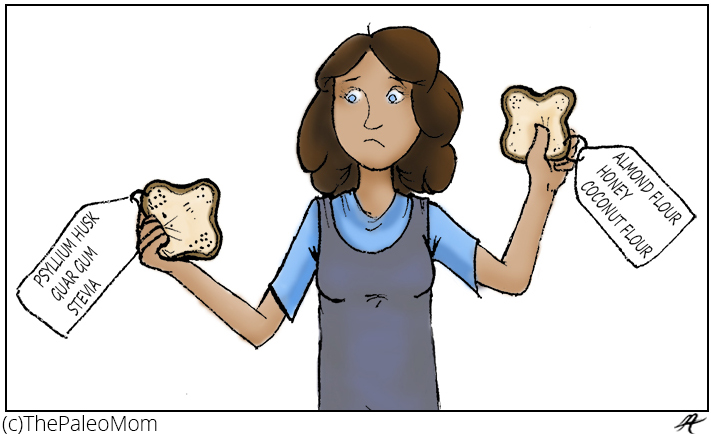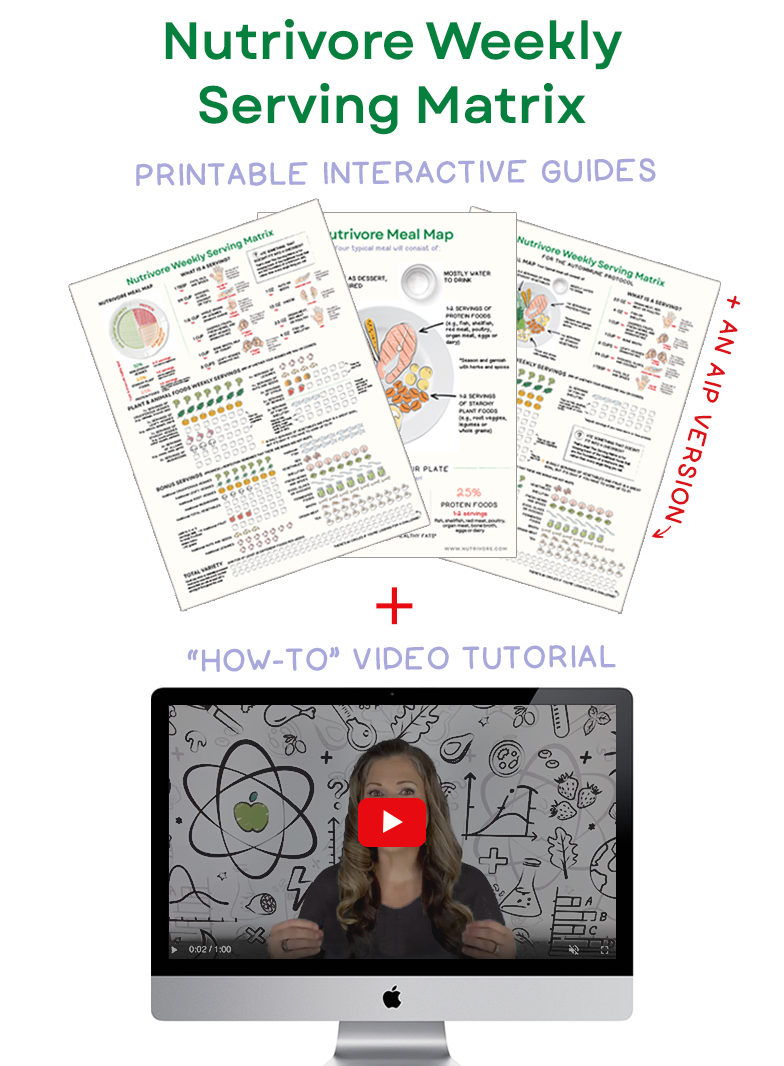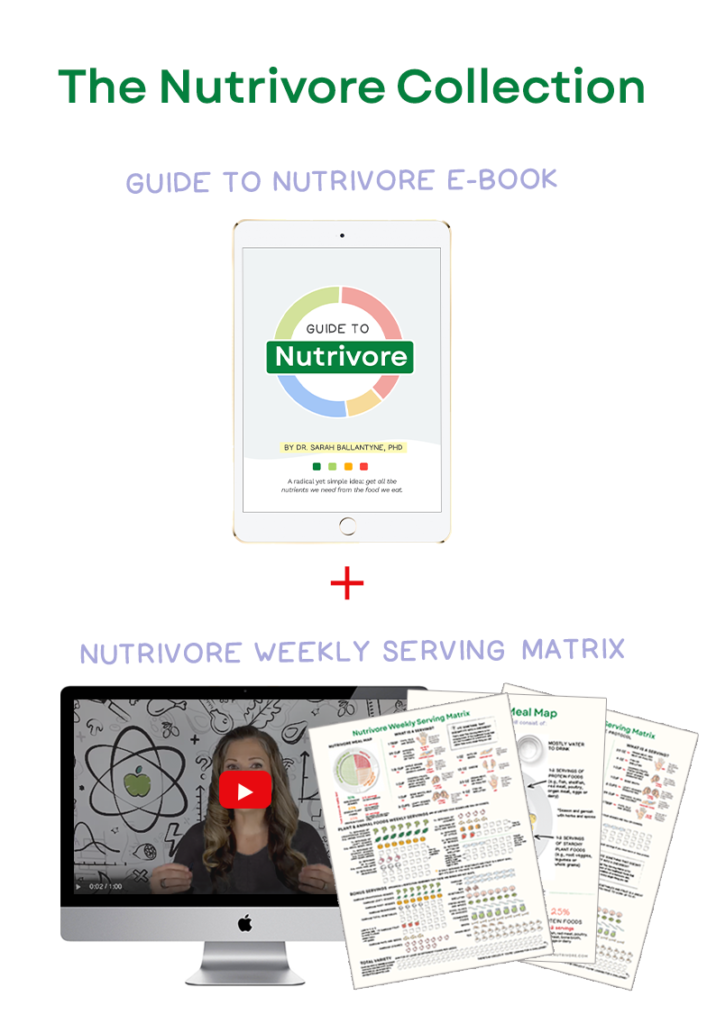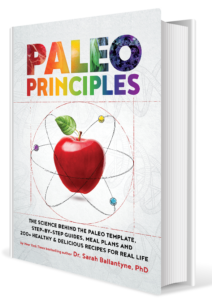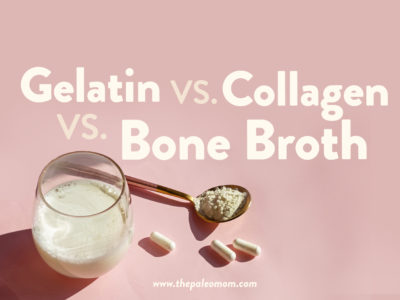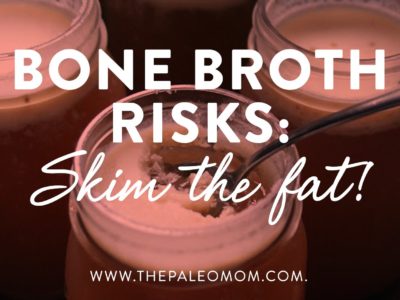It’s pretty typical to be introduced to the Paleo diet with a list of foods to avoid. The stereotypical explanation is that a Paleo diet is no grains, no dairy, no legumes, no refined sugars, no refined oils and no processed/manufactured foods. If you’ve been following me a while, then you know that I strongly dislike (I have a 7-year old who doesn’t let me use the h-word, but feel free to read that here) couching my chosen diet and lifestyle this way. It’s such a negative way to define something that is such a huge positive part of my life. I prefer to focus on what I do eat and define the Paleo diet as a nutrient-dense, whole-foods diet based on eating a variety of quality meat, seafood, eggs, vegetables, fruits, nuts, and seeds.
Table of Contents[Hide][Show]
But, where do these lists of foods to avoid versus foods to eat come from?
There are two chief lines of reasoning when assessing whether or not a food is Paleo: evolutionary biology and contemporary biology/physiology. My inclination is to always use the latter line of reasoning, or to use both together. To me, it’s not as important whether or not caveman ate a certain food compared to what science tells us about how that food actually impacts our health.
Much of the time, evaluating a whether a food should find a place in our diet using these lines of reasoning yields either a resounding yes or a resounding no. For example, our Paleolithic ancestors ate wild game, which is very similar in nutritional profile to grass-fed beef, which is a nutrient-dense food that promotes good health in the context of a diet that also includes vegetables (more details on this important caveat in The Paleo Approach). Our Paleolithic ancestors did not eat wheat, except maybe for during periods of starvation, which contains several very inflammatory proteins that feed gut dysbiosis and directly reduces the integrity of the gut barrier and which contains relatively low levels of essential nutrients (again, tons of details available in The Paleo Approach). The conclusions are easily drawn. Meat=yes Wheat=no
Sometimes, the arguments are not as cut and dry. Alcoholic beverages are a great example. The gene for the enzyme that detoxifies alcohol from the blood is about 18 million years old (where as human evolution only started about 6 million years ago). So, we have been genetically adapted to consuming alcohol since before we were even human. The first evidence of fermented beverages is from about 12,000 years ago. Prior to this, the major source of dietary alcohol was overripe fruit which can contain up to 8% alcohol! With that alcohol content, caveman certainly could have gotten drunk (and there are some animals in the wild that do too!), but this would have been a seasonal occurrence. In contrast, contemporary biological research tells us that alcohol disproportionally feeds E. coli in the gut and directly increases the permeability of the intestinal barrier through its action on the tight junctions between epithelial cells (i.e., alcohol opens up the structures that hold epithelial cells together to create a solid barrier, thereby creating a leaky gut. Read more about the intestinal barrier here.), even with just one drink. That’s bad. But, just to muddy the waters, contemporary biology also shows that there are some beneficial hormetic effects to moderate consumption of alcohol. Moderate consumption of alcohol reduces risk of some diseases, but increases risk of others. When you combine the evidence from evolutionary and contemporary biology, we can conclude that we are probably genetically adapted to moderate and occasional alcohol consumption, but not to the larger and more regular amounts that we typically consume. So, we consider alcohol a gray-area food. Alcohol=maybe (and in moderation)
So, to the point of this post…
Let’s take a closer look at some ingredients that are sneaking their way into Paleo baking these days (both recipes for you to make at home and pre-packaged products): emulsifiers such as xanthan gum, guar gum, carrageenan, cellulose gum and lecithin. Are these ingredients resounding no’s, yes’s, or are they maybe’s?
Okay, there’s an aside that needs to be quickly addressed here. Why am I even concerned with whether or not an ingredient is Paleo if it’s used to make “Paleo” treats??? A cookie isn’t Paleo even if it’s made with dates and nut flours, right? Okay, so maybe you want to jump over to my previous post Is a Paleo Treat Really Paleo? and then come back.
Oh hi! You’re back! Now, rather than getting into a semantics argument or a philosophical debate, let’s just agree that many people do choose to include Paleo treats in their diet from time to time (and it’s no one’s business except the person making the choice). Not that long ago, Paleo treats were made with a limited list of fairly simple ingredients. But you’ve probably noticed that the range of ingredients used for baked goods recipes labelled as Paleo-friendly has increased dramatically in recent months. I personally think it’s awesome to see so many innovative ways to satisfy the need for a treat with healthful ingredients.
But here’s the crux of the matter: of all the possible ingredients for Paleo baked goods, some choices are better than others from a health perspective. Note that’s not necessarily the same as choosing ingredients from a taste or a food chemistry perspective. But if taste and food chemistry were the primary criteria, we’d be cooking with high fructose corn syrup, hydrogenated fats, and gluten. Those are perfectly yummy!
Whether you consider a Paleo treat to be part of your 80% or your 20%, it still matters what the ingredients are. I’ve tackled some of the other ingredients in Paleo baking in these posts: Is Yeast Paleo?, Is Sugar Paleo?, Sugar Vs. Sweeteners, The Trouble with Stevia, The Great Dairy Debate, Paleo Without Nuts, and The Pros and Cons of Almond Flour: Rebuttal to “5 Reasons To Avoid Almond Flour”. And I have plans to tackle other ingredients in a series of upcoming posts.
Nutrivore Weekly Serving Matrix
An easy-to-use and flexible weekly checklist
to help you maximize nutrient-density.
The Weekly Serving Matrix is very helpful! I’ve been eating along these lines but this really helps me know where to focus vs. which foods serve a more secondary role. It’s super helpful and has taken a lot of worry out of my meal planning. Thanks!
Jan
Plus, there’s other places you might encounter these additives. Canned coconut milk typically contains guar gum. Boxed nut milks and coconut milk often contain both guar gum and carrageenan. Coconut milk and almond milk yogurt can contain guar gum, carrageenan and several other members of this food additive family. Chocolate typically contains lecithin. And Paleo-friendly protein powders very commonly contain lecithin and sometimes cellulose gum as well. It’s not just that these emulsifiers are common in gluten-free baked goods or prepackaged breads and cookies labelled as “Paleo”.
I love that there are more and more Paleo-friendly convenience foods out there. But, as more and more packaged goods get marketed to the Paleo community, and unfortunately as more and more of those goods are not actually Paleo, it becomes more and more important to empower you to read labels and determine the merits of a particular product or recipe for yourself.
Now, let’s address the question at hand: are emulsifiers, thickeners and stabilizers Paleo? In order to answer this question, let’s start with defining what exactly these are.
Emulsifiers, Thickeners and Stabilizers: What are They?
This category of food additives include a vast variety of ingredients. Some of the most commonly found include xanthan gum, guar gum, carrageenan, cellulose gum, and lecithin. They all have the properties that they emulsify, thicken, and stabilize, which is why this is considered a single category of food additives. I’ll refer to them collectively as emulsifiers, since this is their primary property. As secondary properties, they typically thicken as well and act as stabilizers and binders. Which one is chosen for a particular purpose depends on the exact chemistry of that additive and the desired effect in the food product it’s being added to.
So, what are they exactly? Xanthan gum, guar gum, carrageenan, cellulose gum, lecithin and other members of this food additive category are polysaccharides, meaning they are complex sugar molecules (sounds innocent enough, right?). They are all very difficult to digest (making them technically types of fiber) and they have detergentlike properties, meaning that they are used to emulsify (i.e., make fat and water mix). Don’t let the word “detergentlike” scare you unnecessarily. Mustard seed and egg yolk are also emulsifiers. Having the property of being an emulsifier isn’t itself the problem. And calling them a type of fiber sounds pretty good, right? Are you feeling a glimmer of hope? Not so fast. There’s a big difference between a whole food that contain nutrients and these manufactured food additives.
These emulsifiers are derived from a variety of sources. For our five specific examples here are their origins:
Guar gum is derived from guar beans (yes, a legume). The guar bean in split and dehusked, and then the endosperm of the beans is milled and screened to obtain the guar gum. The byproducts of this manufacturing process are turned into animal feed for Concentrated Animal Feedlot Operations. As an aside, guar beans are quite high in cyanogenic glycosides (more information about these in The Paleo Approach).
Carrageenan is derived from edible red seaweed (that’s sounds okay so far, right?). The seaweed is dried, ground, sifted and then washed prior to being chemically treated with a hot alkali solution (typically potassium hydroxide, aka caustic potash, also used to make batteries and biodiesel, yum). The carrageenan is then separated out by centrifugation and filtration, then dehydrated back into a powder.
Xanthan gum is secreted by a specific bacteria called Xanthomonas campestris, a bacteria that causes a variety of plant diseases such as Leaf Spot. This bacteria is grown in a liquid containing glucose, sucrose, and/or lactose (typically wheat, corn, soy and/or dairy derived). After the bacteria ferments the sugar, the xanthan gum is precipitated from the liquid (the growth medium) using isopropyl alcohol. It’s then dried and ground into a fine powder.
Cellulose gum (more technically called carboxymethyl cellulose) is extracted from wood pulp and cotton cellulose. The cellulose is chemically modified to make it water soluble first by being treated with sodium hydroxide (aka caustic soda, or lye, used to make soap and detergents) and then with chloroacetic acid. (Fun Fact: Exposure to chloroacetic acid can be fatal if greater than 6% body surface area is exposed). Impurities are then removed with an aqueous solvent.
Lecithin is a byproduct of soybean oil production, but it can also be derived from eggs, canola or sunflower seeds. During soybean oil production, crude oil is obtained by screw pressing and solvent extraction of oilseeds, but this creates a gummy deposit which can coat the machinery. The process of degumming was invested to render these gums insoluble so they could be separated by centrifugation. Originally considered a waste product of vegetable oil production, this gummy stuff now gets additionally processed by enzymatic or chemical modification, solvent extraction, and/or chromatographic purification depending to make lecithin. In addition to polysaccharides, lecithin also contains phospholipids and glycolipids, triglycerides, sterols, free fatty acids and carotenoids.
Knowing how these food additives are manufactured is probably enough to make you wary of consuming most of them (I definitely fall into the “I would rather not eat concentrated Leaf Spot poop, thank you very much” camp). None of these emulsifiers can be considered a whole food, and none would have been found in the diet of our Paleolithic ancestors (whole seaweed, yes, seaweed treated with the goo inside alkaline batteries, no). But, that fact alone isn’t enough to exclude a food from our diet. It’s important to look at the contemporary biology and ask the question:
How do these food additives affect health?
Concerns over the safety of some emulsifiers have been raised in the medical literature, with some scientist calling for their banning from the food supply. In fact, some of these food additives are banned, at least for specific uses in other countries. For example, the use of carrageenan in infant formulas is banned in the European Union.
Guar gum. Guar gum has been shown to increase intestinal permeability (at least in rats), although the mechanism has not been studied. Guar gum has also been shown to increase the growth of a toxic strain of E. coli (enterotoxigenic Escherichia coli) in the small intestine (SIBO, anyone?). In piglets fed a diet with added guar gum, this overgrowth of E. coli lead to increased large intestine weight and overall stunted growth. Another study showed that the addition of guar gum to milk increased the survival of pathogenic bacteria in milk through high heat pasteurization. It remains unknown whether guar gum could increase survival of pathogens in your digestive tract, but the increased growth rate of enterotoxigenic E. coli would suggest that it does.
Carrageenan. Carrageenan increases intestinal permeability. In fact, extensive research has shown that carrageenan causes gastrointestinal inflammation, ulcerations, and colitislike disease in animals. Furthermore, the products of carrageenan degradation through normal digestion are accepted carcinogens. In fact, carrageenan is used to cause cancer in animal models of various tumor types. There is so much evidence demonstrating that carrageenan is unsafe for consumption, that many researchers are blowing the whistle on it. Here’s a quote from a 2001 paper in the journal Environmental Health Perspectives:
“the widespread use of carrageenan in the Western diet should be reconsidered.”
Xanthan gum. Xanthan gum is a highly efficient laxative and can also cause intestinal bloating and diarrhea. It was found to be the culprit behind an increased rate of necrotizing enterocolitis in infants after it was introduced to formula (it has since been banned for use in formula by the FDA). While direct effects on intestinal permeability of the gut microbiome have never been studied, xanthan gum has been shown to be one of the best choices for growing fungi and bacteria in petri dishes in laboratory environments. Added bonus: xanthum gum is commonly contaminated with gluten because the bacteria are grown in a medium that most frequently contains wheat, corn, or soy.
Cellulose gum. Cellulose gum is known to cause massive bacterial overgrowth, damage to the mucus barrier of the small intestine and inflammation in the small intestine in animals, hallmarks of Crohn’s disease. Here’s a quote from a 2009 paper in the journal Inflammatory Bowel Diseases:
“[carboxymethyl cellulose] is an ideal suspect to account for the rise of IBD in the 20th century.”
Lecithin. Although, the only emulsifier in this list that is not a major gut irritant or contributor to gut dysbiosis, that doesn’t mean that lecithin is off the hook! A gut microflora metabolite of lecithin (TMAO) has been strongly linked to increased risk of cardiovascular disease and atherosclerosis, probably by promoting inflammation. How diet might affect this risk, by influencing the type of bacteria growing in the gut, remains unknown. TMAO is also the metabolic product of certain gut bacteria eating carnitine (the discovery of which has been the subject of much anti-red meat talk recently) and Dr. Jeff Leach from the Human Food Project wrote a brilliant post linking the bacteria responsible for producing TMAO from carnitine to grain consumption. Whether the same bacteria are responsible for the production of TMAO from lecithin remains unknown (and is not particularly likely).
Plus, all of these emulsifiers are considered antinutrients because they reduce the absorbability of dietary minerals, such as calcium.
Are there any benefits akin to the hormetic effects from alcohol? Not as such. A few of these emulsifiers have found uses in the medical industry. For example, cellulose gum is a major component of an adhesion barrier called Seprafilm used in abdominal surgeries to prevent postoperative adhesions (it also appears to cause cell damage, so there’s that). Xanthan gum and guar gum have been shown to have utility in the creation of ophthalmic liquids for drug delivery (prescription eye drops). Several of these emulsifiers have been investigated as diet aids; because they expand so prodigiously in the bowels, they create a feeling of fullness that may encourage reduced portion sizes. I’ve heard that eating paper can do the same thing though (just in case it wasn’t obvious, I am not recommending that you eat paper or any of these food additives to lose weight).
Lecithin is the only emulsifier shown to have any properties that might be considered beneficial. It lowers serum cholesterol. However, it does this by interfering with enterohepatic circulation. Since this post is already book chapter-like in scope, I’ll just refer you to page 109 in The Paleo Approach for more on why that’s not such a cool idea. Because of lecithin’s ability to bind with cholesterol, it has been investigated as a supplement to help dissolve gallstones. Between two studies, only one patient actually experienced a reduction in gallstone size, which is pretty underwhelming evidence for a beneficial effect. I wasn’t able to find any studies to support the use of lecithin supplementation as a natural treatment for mastitis (although it’s often recommended) or for MS (there’s some interesting research on endogenous lecithin, but this is a completely different beast). Lecithin is also being investigated as a therapy for ulcerative colitis (efficacy has not yet been determined but a Phase II clinical trial is underway), so there’s a glimmer of hope there.
Crazy, right? At least alcohol has the added bonus of making you intoxicated. In all seriousness though, I’m not quite sure what the upside to any of these additive are. Not when there’s great emulsifiers and binders out there to use in Paleo baking instead, whole food ingredients like egg, mustard, gelatin, and applesauce (you might like to read The Science and Art of Paleofying—Part 2 Binders). There’s a long list of cons to these additives, and no pros, when it comes to evaluating these ingredients from the perspective of their effect on our health. And as already mentioned, if taste and food chemistry are your primary criteria for choosing an ingredient, well, I’m not quite sure what you’re doing reading a Paleo diet blog.
Take Home Message: There’s a big difference between using dried fruit and nuts and root vegetable starches to create a Paleo-friendly baked good compared to one using ingredients like those discussed above. And while definitely not as problematic as gluten, it’s pretty poor planning to replace one gut irritant ingredient with another for the sake of food texture. We are all individuals, and I won’t judge if you choose to consume a gluten-free treat made with xanthan gum as an occasional indulgence. But, if you see a product or recipe labelled as Paleo-friendly that uses these ingredients, know that it is mislabeled. Guar gum, carrageenan, xanthan gum, cellulose gum, and lecithin are not Paleo.
Further Reading
Babbar SB, Jain R. Xanthan gum: an economical partial substitute for agar in microbial culture media. Curr Microbiol. 2006 Apr;52(4):287-92.
Beal J, et al., Late onset necrotizing enterocolitis in infants following use of a xanthan gum-containing thickening agent. J Pediatr. 2012 Aug;161(2):354-6.
Daly J, et al., The effect of feeding xanthan gum on colonic function in man: correlation with in vitro determinants of bacterial breakdown. Br J Nutr. 1993 May;69(3):897-902.
Delahunty T, et al., Intestinal permeability changes in rodents: a possible mechanism for degraded carrageenan-induced colitis. Food Chem Toxicol. 1987 Feb;25(2):113-8.
Gaby AR. Nutritional approaches to prevention and treatment of gallstones. Altern Med Rev. 2009 Sep;14(3):258-67.
Lallès J.P., et al., High-viscosity carboxymethylcellulose reduces carbachol-stimulated intestinal chloride secretion in weaned piglets fed a diet based on skimmed milk powder and maltodextrin. Br J Nutr. 2006 Mar;95(3):488-95.
McDonald D.E., et al., Adverse effects of soluble non-starch polysaccharide (guar gum) on piglet growth and experimental colibacillosis immediately after weaning. Res Vet Sci. 1999 Dec;67(3):245-50.
Piyasena P and McKellar RC. Influence of guar gum on the thermal stability of Listeria innocua, Listeria monocytogenes, and gamma-glutamyl transpeptidase during high-temperature short-time pasteurization of bovine milk. J Food Prot. 1999 Aug;62(8):861-6.
Rampone AJ. The effect of lecithin on intestinal cholesterol uptake by rat intestine in vitro. J Physiol. 1973 Mar;229(2):505-14
Shiau SY, and Chang GW. Effects of certain dietary fibers on apparent permeability of the rat intestine. J Nutr. 1986 Feb;116(2):223-32.
Stremmel W, and Gauss A. Lecithin as a therapeutic agent in ulcerative colitis.Dig Dis. 2013;31(3-4):388-90. doi: 10.1159/000354707. Epub 2013 Nov 14.
Swidsinski A, et al., Bacterial overgrowth and inflammation of small intestine after carboxymethylcellulose ingestion in genetically susceptible mice. Inflamm Bowel Dis. 2009 Mar;15(3):359-64. doi: 10.1002/ibd.20763.
Tang, WH; et al. “Intestinal microbial metabolism of phosphatidylcholine and cardiovascular risk.”. N Engl J Med. Apr 25, 2013; 368(17): 1575–1584.
Tobacman, J. K., Review of harmful gastrointestinal effects of carrageenan in animal experiments. Environ Health Perspect. 2001;109(10):983-994
Watt, J. and Marcus, R., Danger of carrageenan in foods and slimming recipes, Lancet. 1981;317(8215):338
Yang J, et. al., In vitro characterization of the impact of selected dietary fibers on fecal microbiota composition and short chain fatty acid production. Anaerobe. 2013 Oct;23:74-81. doi: 10.1016/j.anaerobe.2013.06.012. Epub 2013 Jul 4.
Yıldız E, et al., Tranexamic Acid and hyaluronate/carboxymethylcellulose create cell injury. JSLS. 2014 Jul;18(3).
Looking for more?
 The Paleo Approach is a complete guide to using diet and lifestyle to manage autoimmune disease. It answers all of the whats, the whys, and the hows!
The Paleo Approach is a complete guide to using diet and lifestyle to manage autoimmune disease. It answers all of the whats, the whys, and the hows!
Find The Paleo Approach at:
- All major online retailers, including Barnes&Noble, Target, Walmart, and Amazon.com.
- Costco
- Indiebound
- Book Depository


